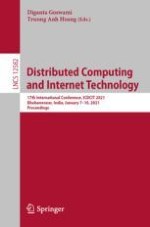2021 | Book
Distributed Computing and Internet Technology
17th International Conference, ICDCIT 2021, Bhubaneswar, India, January 7–10, 2021, Proceedings
Editors: Diganta Goswami, Truong Anh Hoang
Publisher: Springer International Publishing
Book Series : Lecture Notes in Computer Science
